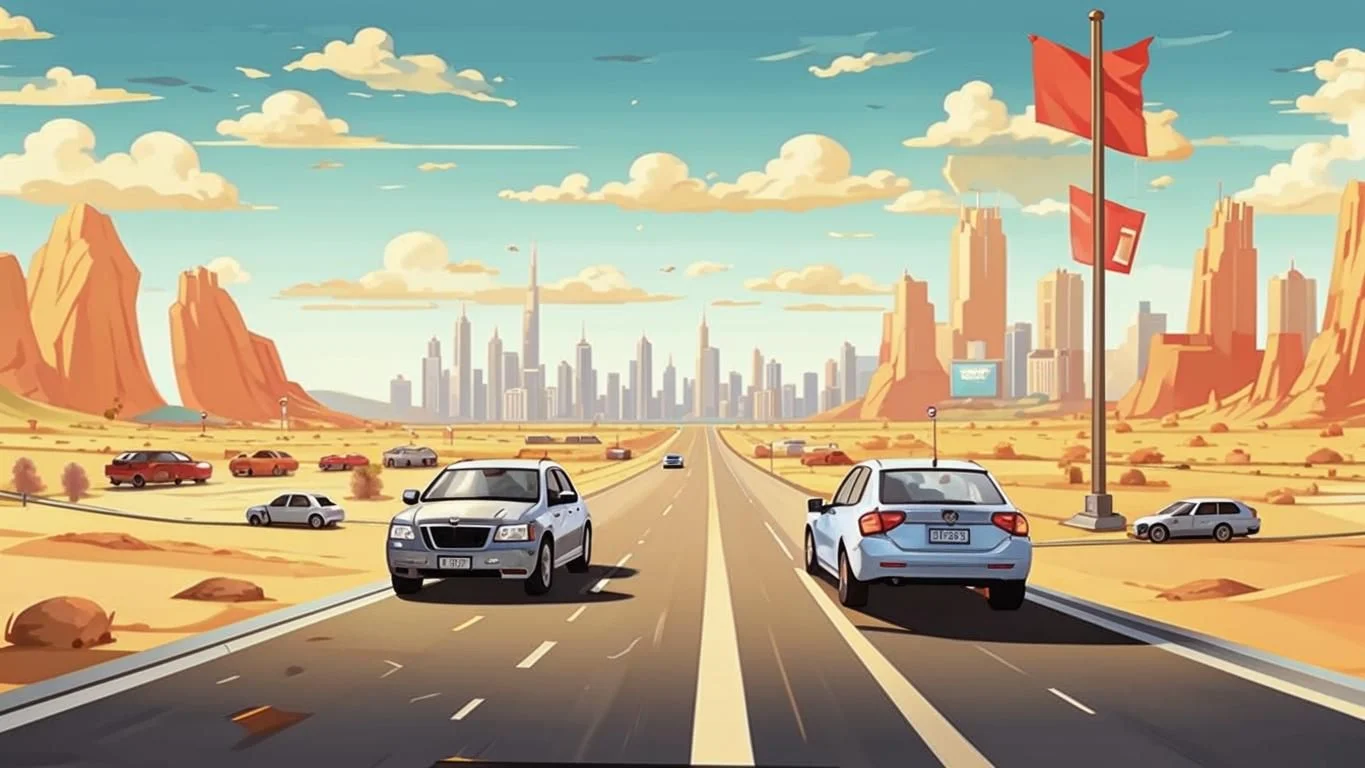International Driving licenses, driving regulations and fines in the UAE and Oman: A complete guide
120
9/16/2025

The content of the article:
- International IDP Rights (IDP) — registration procedure
- Residence permit in the UAE and driving rules
- Penalties and “black points” in the Emirates
- To drive or not to drive: a guide to driving in Oman
Traveling by car is always a pleasure: music, wind in your face, new experiences. Therefore, even in another country, regardless of the purpose of arrival, many people try to immediately buy a car or rent it. Today we will talk about two states in which the driving rules are identical. These are Oman and the Emirates. There are no problems buying a car or renting it in the two richest states of the Arab world, but whether your driver's license will fit or they will have to be replaced, let's figure it out. In Dubai, you can drive a car with a license issued in the country that is included in this list:
- Gulf Cooperation Council countries — Bahrain, Kuwait, Oman, Qatar and Saudi Arabia;
- Great Britain;
- USA and Canada;
- Japan and South Korea;
- EU countries
If your country is not on this list, then you need to obtain an International Driver's License (IDP) or IDP. In fact, an IDP is a legal translation of your driver's license. It can be issued in 10 different languages and be valid for exactly one year. The procedure is short, but it is advisable to apply for such rights in your country. However, such a driver's license is suitable for those who do not plan to stay in the Emirates for a long time. You can apply for an IDP while already in Dubai, but before you travel, be sure to clarify the most up-to-date information about driving rules, what is the procedure for obtaining a driver's license and how long it will take.
If you are the owner of a residence permit in the UAE, then the following rules apply to you:
- you can drive a car from the age of 18, and rent it only from the age of 21;
- Residents are required to issue and obtain a local driving permit;
- again, if your country is not on the list of countries whose rights can be simply exchanged (relevant for the CIS countries and the Russian Federation), then you will need to complete training and pass exams;
- the procedure for registration of rights begins with the preparation of a dossier: you need to visit one of the examination centers and be tested in the tests;
- with good results — you have passed the theory and driving test — the license is issued for a period of 2 years. They can be extended;
- cars can be bought, rented, and imported from your country;
- When importing, a valid residence permit and a vehicle registration certificate are required. If your car is older than 10 years, then you need to check with the RTA whether it is possible to import it into the Emirates and register it. The costs in this case will be — state duties at customs (5% of the cost of the car), transportation of the car (depending on the region), insurance (1%);
- when buying a new car in the salon, you are exempt from car registration for 2 years;
- when buying a used car — registration through the registration service and the traffic police;
- Once a year, you need to have your vehicle checked for safety by the RTA and renew your registration. The check is very strict: the car is checked “from and to". If your vehicle has not passed inspection, you have a month to carry out its maintenance, eliminating the noted problems;
- when renewing registration, it is important that all fines are paid. Otherwise, you will not even be allowed to register;
- the car must necessarily have an insurance policy, an emergency triangle, a fire extinguisher and a spare wheel.
Now let's talk a little bit about the rules of the road. Many foreigners do not immediately pay attention to the presence of cameras and toll roads, and then they are surprised when they receive “round” amounts of fines upon re-registration.
Please note! The speed limit is set as follows:
- residential area — 45 km / h,
- in the city itself — there is a limit of 70-80 km / h
- on the highway — 110 km / h
- in parking lots and entrances — 25 km / h
(The amount of the fine depends on the degree of violation of the rules of a particular Emirate)
- you can talk on the phone strictly on speakerphone. If the camera captures the phone in your hands while driving — fine;
- Children under 10 years old are not allowed to sit in the front seat, a child car seat must be installed for preschool children.;
- The driver and passengers must use seat belts;
- for driving under the influence of alcohol or drugs — deprivation of rights and imprisonment for 36 months. The amount of the fine in this case will be large (from 16 thousand dirhams);
- Be careful on toll roads: as a rule, they are marked with special signs with the words "Salik” or “Toll Gate”;
- the police are constantly patrolling and checking the correctness of parking. Please note that there are paid parking spaces, and there are free ones. This is indicated at the entrance to such a parking lot. Well, it is important how you parked: if you make it inconvenient for other drivers to leave or enter, you will be issued a fine;
- in addition to fines, police officers in the Emirates use a system of “black points”. A maximum of 24 points can be scored for all violations, and then the motorist receives a driving ban for 12 months. Points are awarded depending on the severity of the violation itself. For example, for running a red light — 8 points, for talking on the phone — 4 points, but for a lot of speeding you can get 23 at once!
- be polite, do not be indignant and do not gesture, even if you are cut off or the turn signals are not turned on. You can be severely fined for rude statements and outrage.
In Oman, the system of obtaining and registering rights is almost similar to the Emirates. There are certain points that can be noted. Despite the fact that it is not officially necessary to have international rights in Oman, it is still worth registering them, since they act as a kind of insurance on the roads. However, if you plan to stay in Oman and drive for more than three months, you will need to obtain a local driver's license. Migrants and residents receive a driver's license with the same rights as the local population. Additionally, an application form in the form of a driving permit for foreign citizens will be required. To do this, you need to register with the Royal Oman Police (ROP). First of all, your eyesight will be checked, a number of tests will be conducted on your knowledge of traffic rules and a driving test from an Omani instructor. Once again, we draw your attention to the fact that according to an international driver's license, you can use a car for no more than three months. If this period is extended, you will be required to have a residence permit and a local driver's license. Driving schools in Oman operate according to the country's legislation and it will not be possible to “bypass” them in a roundabout way. The main thing is to follow all the rules and recommendations, and there will be no problems. It is noteworthy that until 2019, there was a rule in Oman — men were forbidden to take the driving test in a car with an automatic transmission. Today, this rule has been simplified, driving can be passed on any car.
When renting a vehicle, it is important to remember that the minimum age for this is 21 years.
It is better to rent through trusted agencies, because a certain area requires a certain car. For example, there are destinations in Oman that are not accessible by public transport and where only an SUV can pass. Accordingly, your choice of car should be based on this.
If you have a residence permit in the UAE and you have already received your license there, then in Oman you can safely drive them without registration and confirmation (they are valid in the Persian Gulf countries). The traffic rules in Oman are the same as in the neighboring country. For drunk driving — a fine and imprisonment. Remember about the car seat for children and do not put a child under 10 years old in the front seat. There are not as many paid destinations in Oman as in the UAE, but they are here, so it is better to plan your route in advance and clarify how you can pay for entry to the toll road. One of the biggest violations in Oman is considered to be running a red light. If you can get a fine of 50 OMR (Omani rials) for speeding, then running a red light can cost up to 500 OMR or even a year in prison.
In addition to the generally accepted traffic signs in Oman, you can find unique road signs specific only to this country. You can see a warning about camels that can safely cross the road; a warning sign about dunes or rushing streams that appear during heavy rains. They are usually accompanied by a sign saying “If the water turns red, stop!” and not far from it there is a white-red column that shows the permissible water level at which you can move.
A large amount of transport, of course, creates huge traffic jams on the roads. Muscat is loaded almost constantly. Some use provincial roads for detours. In this case, you need to remember about the speed limit and about sudden animals that can cross the road.
Do not forget about driving culture in Oman. Despite the fact that local drivers sometimes violate traffic rules, it is by no means possible to show emotions and aggression. The police record all illegal actions, and a fine may come to you quite unexpectedly. Always carry your documents with you. You can simply be stopped on the road and your identity checked, although this rarely happens. If you do not know Arabic, then immediately warn that you speak only English.
Car travel by car is an exciting activity. Getting to know the history, sights of the country, visiting different destinations — it's all nice to do on your personal car. But don't forget that Oman and the Emirates are Muslim countries where there are certain rules to your dress code, even when you're driving. Do not wear too revealing clothes, respect the culture of these countries and travel with pleasure. Before planning a trip, it is better to study more thoroughly what problems you may face as a driver. Write down all the necessary phone numbers (ambulance, police call). Learn the rules for emergency situations. Download the necessary navigation applications of your chosen country and feel free to step on the gas, not forgetting about the speed limit.
Are there any questions or do you need advice?
Leave a request
Our expert will contact you to discuss tasks, choose solutions and be in touch at each stage of the transaction.
